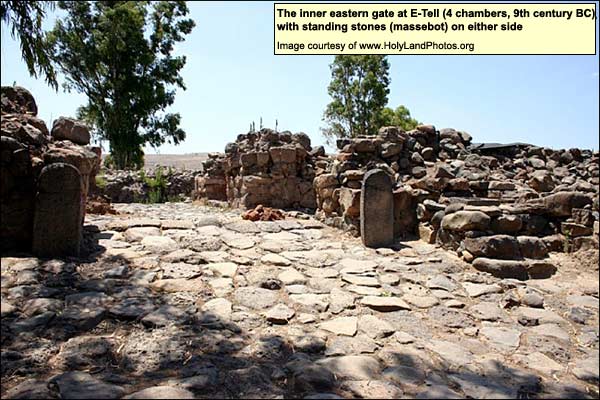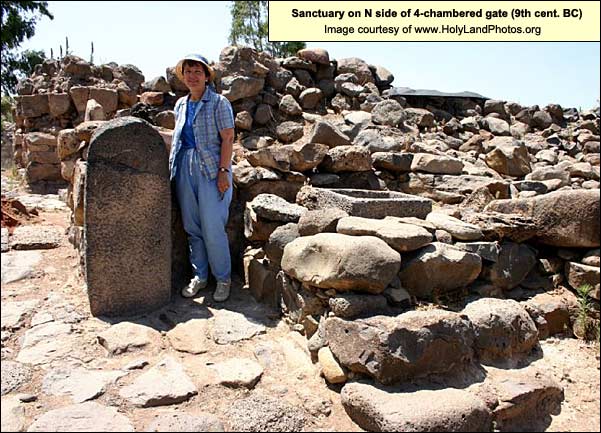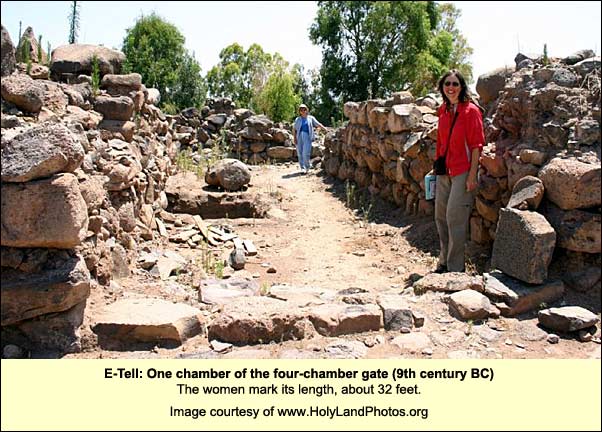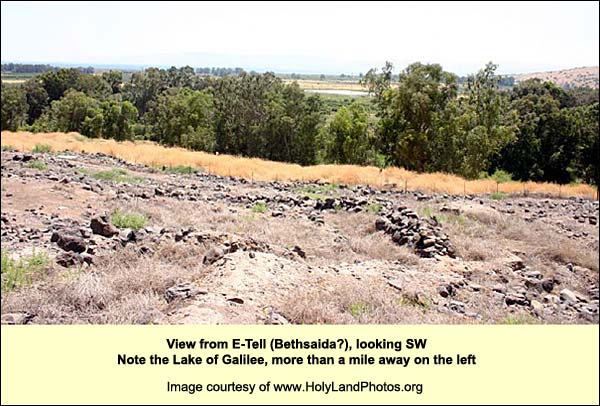Bethsaida: Two possibilities
Clear, however, is the fact that a large, well-fortified city existed on e-Tell in the Iron Age 1200 BC ~ 586 BC The mound of its upper city was 400 meters long by 200 wide, covering 20 acres. (For comparison, Hazor's upper city also has 20 acres and Megiddo's 12.) The major digging, so far, has been on the eastern side, in the area of the gate and the ramparts, which date from the 9th century BC. The walls were more than 20 feet thick (thicker than those at Hazor and Megiddo).
The inner gate, with four chambers, is the largest of its type yet unearthed in this country. One chamber contained a ton of burnt barley. The gate's main door was flanked by towers that housed small sanctuaries. In one of these, beneath the rubble of destruction, were incense burners of a type from the last half of the 8th century BC. The gate, then, would have been destroyed by Tiglath-pileser III of Assyria, during his destructive sweep of 735. The rubble that covered the burners included part of a standing stone (masseba); when its pieces were found and reassembled, there appeared a figure with a bull's head, wearing a sword. (See the image by going here and scrolling down.) This was likely the image of a god who, it was believed, would guard the gate. (See Dan.)



Just north of the gate, the diggers found the remains of a large palace (50 feet x 92 feet). The Assyrians did it no harm. They limited their destruction (as at Dan) to fortifications, in order to inhibit revolt. Yet the site never flourished again. Here then was an important city from First Testament times, but we do not know its name. One cannot assume a firm connection with Israel, because there were no bridgesIn Assyria bridges are mentioned from the 11th century BC. (The Egyptians used ferries.) Yet the First Testament lacks a word for bridge, and no remains of any have been found in the land for this period. Except when miracles occur, the Israelites are always portrayed as fording. The location of fords in this land was a major factor in determining the location of cities and roads. It was the Romans who first made bridges general, building them wherever they conquered in the land back then, and the upper Jordan could not have been easily forded here. The connection with Damascus might well have been stronger than any that the city had with the capitals of Israel or Judah. Tiglath-pileser's target was not only Israel, but also Damascus. Every other tell of comparable size exists at an ancient junction, either of land routes or of land and sea. This one seems an exception: it is more than a mile from the Lake of Galilee.

The city may not have been so far from the lake 3000 years ago, however. Near the foot of the tell, the archaeologists found lake clays containing crustacean microorganisms. The clays were covered by boulders and gravel, among which were animal bones; according to the archaeologists, these could be dated by the Carbon-14 method to the first four centuries AD. Perhaps the city of 3000 years ago sat on the edge of a lagoon that joined it to the lake. Three rivers from the Golan Heights deposit mud and rocks, forming the delta that stretches from here to the south. The deposits could have later filled the lagoon. Who lived in this large, unidentified city? Biblical references place the "people of Geshur" in the area. For example, in Joshua 12:5 we read that Og, king of Bashan, "ruled in Mount Hermon, and in Salecah, and in all Bashan, to the border of the Geshurites and the Maacathites, and half Gilead, the border of Sihon king of Heshbon." This may have been a major city in the land of Geshur, perhaps its capital (until the region came under the sway of Damascus). King David, we know, married Maacah daughter of Talmai king of Geshur (2 Samuel 3:3), and she bore him Absalom and Tamar. After killing his half-brother Amnon (who had raped Tamar), Absalom fled to Talmai in Geshur, where he stayed three years (2 Samuel 13:37-38). This city may have been home to him then, until his father let him return to Jerusalem. The dig at the tell revealed three levels of habitation: 1) A settlement in the Early Bronze Age, 3000-2700 BC. 2. The Iron Age city we have just described. 3. A settlement from the 2nd century BC until 67 AD, the start of the Jewish revolt against Rome. The third is the object of greatest interest to most people, because here, it is hoped, we may have Bethsaida, the fishing village of the Gospels. According to John 1:44 (but not the first three Gospels), this village was the home town of Peter, Andrew, and Philip. In Bethsaida, as well as Capernaum and Chorazin, Jesus performed most of his miracles; he cursed all three for their failure to repent. He healed a blind manMark 8: 22-25 He came to Bethsaida. They brought a blind man to him, and begged him to touch him. He took hold of the blind man by the hand, and brought him out of the village. When he had spit on his eyes, and laid his hands on him, he asked him if he saw anything. He looked up, and said, "I see men; for I see them like trees walking." Then again he laid his hands on his eyes. He looked intently, and was restored, and saw everyone clearly. He sent him away to his house, saying, "Don't enter into the village, nor tell anyone in the village." here. In Luke's account, the feeding of the 5000 occurred in the area of Bethsaida. There are not many other candidates. The village would have had to be in the area ruled by Herod Philippus, son of Herod the Great and brother of Antipas. For Josephus writes that Philippus, in addition to Caesarea Philippi, "also advanced the village Bethsaida, situate at the lake of Gennesareth [the Sea of Galilee - SL], unto the dignity of a city, both by the number of inhabitants it contained, and its other grandeur, and called it by the name of Julias, the same name with Caesar's daughter." (Josephus' AntiquitiesJosephus Flavius. Antiquities of the Jews, translated by William Whiston 18: Ch. 2, Par.1). In fact Philippus would have re-named the city after Augustus' wife, who had changed her name from Livia to Julia on becoming a widow in 14 AD.) JosephusJosephus Flavius (36 – 100 AD), Jewish general, one of two directing the revolt against Rome in Galilee. After Vespasian captured him, he prophesied the latter would be emperor. When this proved true, the Romans honored him. He then turned historian, writing The Jewish War, The Antiquities of the Jews and many other books. Because of a paragraph about John the Baptist (and maybe a sentence about Jesus), the Church preserved his works. adds that Philippus "died at Julias; and when he was carried to that monument which he had already erected for himself beforehand, he was buried with great pomp." (Antiquities 18: Ch.4, Par.6.) That would rule out locations west of the Jordan's delta, where Philippus did not rule. (John 12:21 mentions that the Apostle Philip was from "Bethsaida in Galilee," but this need not deter us. The upper Jordan was now bridged; functionally, a location on the delta could easily have been thought of as part of Galilee.) The passages from Josephus raise the first major problem in locating Bethsaida at e-Tell. We would expect archaeology to reveal some sign of a city at this time, with "added residents" and "strengthened fortifications," the kind of place in which a tetrarch would live out his final days and be buried with pomp. No such place has come to light. Instead, the diggers found a few houses of undressed stones with extremely large courtyards. They claim to have discovered a Roman temple, but this is disputed: "Excavations of Hellenistic cities in the land of Israel usually reveal remains such as public buildings, colonnades, and so on. However, no such remains were found at this site. There were only a few dressed basalt stones, one column base of limestone and the end of a small column. As for public buildings, only the foundations of a building of basalt stones were found (dimensions: 6 by 20 meters). According to the excavators, the building was erected in the year 30 C.E. and remained in existence until the end of the second century. In their opinion the building was a Roman temple dedicated to Julias, the wife of Caesar Augustus, after whom the city was named. [Augustus' wife Livia took the name Julia after his death in 14 AD - SL.] There is no real support for this suggestion, however. The few ornamental basalt stones found on the mound-a basalt lintel with meandering and floral motifs, and two stones decorated with rosettes resembling stones found in the nearby ed-Dikkeh synagogue-were assumed to be part of this temple. This assumption is also open to question since none of these stones was found in situ. The above constitute the sum total of the Hellenistic-Roman architectural elements found at et-Tell." (The above paragraph is from an article by Mendel Nun. Although not an archaeologist, Nun is widely recognized as an expert on the Sea of Galilee. He is an Antiquities Trustee of the Israel Antiquities Authority.) There are other problems, too, in identifying the place on e-Tell as Bethsaida. The Gospels (as well as the name Bethsaida: from the Aramaic bet tsaida, "fishing place") indicate that in the time of Jesus' mission, the latter was a fishing village. Mendel Nun (toward the end of his article) argues that the fishing implements found on e-Tell are too sparse to indicate commercial fishing. Nun proposes as an alternative the site called el-Araj, which has yet to be excavated. The Bethsaida Excavation Project did a small random probe there in 1987 (4 x 4 meters), finding remains from the Byzantine period and later. They performed that probe in the spring, writes Nun, when the lake covered much of the ground, and they saw only a narrow strip of ruins. (On the ever changing level of the lake.) In the fall of 1990, however, when the lake was lower, a team from the Israel Antiquities Authority did a surface survey at el-Araj and found ruins spread over a much larger area, surrounding a mound. These included remains from the Hellenistic and Roman periods. Only a systematic excavation, performed in the summer and fall when the area is above water, will decisively answer the question as to whether el-Araj was in fact Bethsaida. ("Kefar Nahum Map, Survey," "Excavations and Surveys in Israel, 1991," 'Atiqot 10 [1992], 87.)



Just north of the gate, the diggers found the remains of a large palace (50 feet x 92 feet). The Assyrians did it no harm. They limited their destruction (as at Dan) to fortifications, in order to inhibit revolt. Yet the site never flourished again. Here then was an important city from First Testament times, but we do not know its name. One cannot assume a firm connection with Israel, because there were no bridgesIn Assyria bridges are mentioned from the 11th century BC. (The Egyptians used ferries.) Yet the First Testament lacks a word for bridge, and no remains of any have been found in the land for this period. Except when miracles occur, the Israelites are always portrayed as fording. The location of fords in this land was a major factor in determining the location of cities and roads. It was the Romans who first made bridges general, building them wherever they conquered in the land back then, and the upper Jordan could not have been easily forded here. The connection with Damascus might well have been stronger than any that the city had with the capitals of Israel or Judah. Tiglath-pileser's target was not only Israel, but also Damascus. Every other tell of comparable size exists at an ancient junction, either of land routes or of land and sea. This one seems an exception: it is more than a mile from the Lake of Galilee.

The city may not have been so far from the lake 3000 years ago, however. Near the foot of the tell, the archaeologists found lake clays containing crustacean microorganisms. The clays were covered by boulders and gravel, among which were animal bones; according to the archaeologists, these could be dated by the Carbon-14 method to the first four centuries AD. Perhaps the city of 3000 years ago sat on the edge of a lagoon that joined it to the lake. Three rivers from the Golan Heights deposit mud and rocks, forming the delta that stretches from here to the south. The deposits could have later filled the lagoon. Who lived in this large, unidentified city? Biblical references place the "people of Geshur" in the area. For example, in Joshua 12:5 we read that Og, king of Bashan, "ruled in Mount Hermon, and in Salecah, and in all Bashan, to the border of the Geshurites and the Maacathites, and half Gilead, the border of Sihon king of Heshbon." This may have been a major city in the land of Geshur, perhaps its capital (until the region came under the sway of Damascus). King David, we know, married Maacah daughter of Talmai king of Geshur (2 Samuel 3:3), and she bore him Absalom and Tamar. After killing his half-brother Amnon (who had raped Tamar), Absalom fled to Talmai in Geshur, where he stayed three years (2 Samuel 13:37-38). This city may have been home to him then, until his father let him return to Jerusalem. The dig at the tell revealed three levels of habitation: 1) A settlement in the Early Bronze Age, 3000-2700 BC. 2. The Iron Age city we have just described. 3. A settlement from the 2nd century BC until 67 AD, the start of the Jewish revolt against Rome. The third is the object of greatest interest to most people, because here, it is hoped, we may have Bethsaida, the fishing village of the Gospels. According to John 1:44 (but not the first three Gospels), this village was the home town of Peter, Andrew, and Philip. In Bethsaida, as well as Capernaum and Chorazin, Jesus performed most of his miracles; he cursed all three for their failure to repent. He healed a blind manMark 8: 22-25 He came to Bethsaida. They brought a blind man to him, and begged him to touch him. He took hold of the blind man by the hand, and brought him out of the village. When he had spit on his eyes, and laid his hands on him, he asked him if he saw anything. He looked up, and said, "I see men; for I see them like trees walking." Then again he laid his hands on his eyes. He looked intently, and was restored, and saw everyone clearly. He sent him away to his house, saying, "Don't enter into the village, nor tell anyone in the village." here. In Luke's account, the feeding of the 5000 occurred in the area of Bethsaida. There are not many other candidates. The village would have had to be in the area ruled by Herod Philippus, son of Herod the Great and brother of Antipas. For Josephus writes that Philippus, in addition to Caesarea Philippi, "also advanced the village Bethsaida, situate at the lake of Gennesareth [the Sea of Galilee - SL], unto the dignity of a city, both by the number of inhabitants it contained, and its other grandeur, and called it by the name of Julias, the same name with Caesar's daughter." (Josephus' AntiquitiesJosephus Flavius. Antiquities of the Jews, translated by William Whiston 18: Ch. 2, Par.1). In fact Philippus would have re-named the city after Augustus' wife, who had changed her name from Livia to Julia on becoming a widow in 14 AD.) JosephusJosephus Flavius (36 – 100 AD), Jewish general, one of two directing the revolt against Rome in Galilee. After Vespasian captured him, he prophesied the latter would be emperor. When this proved true, the Romans honored him. He then turned historian, writing The Jewish War, The Antiquities of the Jews and many other books. Because of a paragraph about John the Baptist (and maybe a sentence about Jesus), the Church preserved his works. adds that Philippus "died at Julias; and when he was carried to that monument which he had already erected for himself beforehand, he was buried with great pomp." (Antiquities 18: Ch.4, Par.6.) That would rule out locations west of the Jordan's delta, where Philippus did not rule. (John 12:21 mentions that the Apostle Philip was from "Bethsaida in Galilee," but this need not deter us. The upper Jordan was now bridged; functionally, a location on the delta could easily have been thought of as part of Galilee.) The passages from Josephus raise the first major problem in locating Bethsaida at e-Tell. We would expect archaeology to reveal some sign of a city at this time, with "added residents" and "strengthened fortifications," the kind of place in which a tetrarch would live out his final days and be buried with pomp. No such place has come to light. Instead, the diggers found a few houses of undressed stones with extremely large courtyards. They claim to have discovered a Roman temple, but this is disputed: "Excavations of Hellenistic cities in the land of Israel usually reveal remains such as public buildings, colonnades, and so on. However, no such remains were found at this site. There were only a few dressed basalt stones, one column base of limestone and the end of a small column. As for public buildings, only the foundations of a building of basalt stones were found (dimensions: 6 by 20 meters). According to the excavators, the building was erected in the year 30 C.E. and remained in existence until the end of the second century. In their opinion the building was a Roman temple dedicated to Julias, the wife of Caesar Augustus, after whom the city was named. [Augustus' wife Livia took the name Julia after his death in 14 AD - SL.] There is no real support for this suggestion, however. The few ornamental basalt stones found on the mound-a basalt lintel with meandering and floral motifs, and two stones decorated with rosettes resembling stones found in the nearby ed-Dikkeh synagogue-were assumed to be part of this temple. This assumption is also open to question since none of these stones was found in situ. The above constitute the sum total of the Hellenistic-Roman architectural elements found at et-Tell." (The above paragraph is from an article by Mendel Nun. Although not an archaeologist, Nun is widely recognized as an expert on the Sea of Galilee. He is an Antiquities Trustee of the Israel Antiquities Authority.) There are other problems, too, in identifying the place on e-Tell as Bethsaida. The Gospels (as well as the name Bethsaida: from the Aramaic bet tsaida, "fishing place") indicate that in the time of Jesus' mission, the latter was a fishing village. Mendel Nun (toward the end of his article) argues that the fishing implements found on e-Tell are too sparse to indicate commercial fishing. Nun proposes as an alternative the site called el-Araj, which has yet to be excavated. The Bethsaida Excavation Project did a small random probe there in 1987 (4 x 4 meters), finding remains from the Byzantine period and later. They performed that probe in the spring, writes Nun, when the lake covered much of the ground, and they saw only a narrow strip of ruins. (On the ever changing level of the lake.) In the fall of 1990, however, when the lake was lower, a team from the Israel Antiquities Authority did a surface survey at el-Araj and found ruins spread over a much larger area, surrounding a mound. These included remains from the Hellenistic and Roman periods. Only a systematic excavation, performed in the summer and fall when the area is above water, will decisively answer the question as to whether el-Araj was in fact Bethsaida. ("Kefar Nahum Map, Survey," "Excavations and Surveys in Israel, 1991," 'Atiqot 10 [1992], 87.)